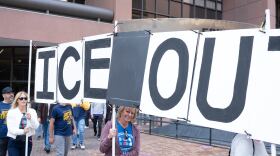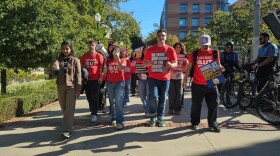When most of us think of honeybees buzzing around our flowers and doing the hard work of pollination, we don't think of them as an invasive species. But that's exactly what they are in San Diego.
And they're bad for some of San Diego’s plant life, especially when it comes to our region’s native plants, according to UC San Diego researchers.
“Seeds or seedlings that are produced through honeybee pollination were anywhere between two to 10 times less fit, compared to the seed and seedlings that are cross-pollinated by hand or by native pollinators,” said Dillon Travis, a former UC San Diego ecologist and author of a paper in the Proceedings of the Royal Society B.
Honeybees were brought to California in the late 1800s to pollinate flowering crops. Now they are so numerous locally and statewide that an estimated 90% of the bees visiting flowering plants in San Diego are honeybees.
The problem is the honeybees you see buzzing around plants have a higher calling — their first priority is to serve their colony and the queen bee. This means they must be efficient pollinators. So they spend a lot of time on the flowers of a single plant in order to gather as much nectar as possible in one place.
And when they move from flower to flower on the same plant, they are self-pollinating that plant. Think of it as inbreeding.
Meanwhile, the 600 different species bees that actually are native to Southern California behave very differently, moving quickly from one plant to the next. That results in a lot more cross pollination, which is a much healthier process for native plants.

This is partly because they are solitary bees that don’t need to gather nectar to feed a whole colony.
“Native bees don’t communicate the location of resources to others in a colony. They are only providing for themselves and their offspring so they don’t have to be as efficient as honeybees in their foraging,” Travis said.
Black sage and white sage were among the common native plants the UC San Diego research team examined. Without cross pollination, the offspring of those plants are less likely to germinate, develop and reproduce.
That leaves the question: Is there anything that can be done about dominance of honeybees in San Diego County?
“I personally would love to poison every feral hive in a 20-by-20 mile square and watch for 10 years to see if we get more native bees, but I don’t think that’s possible,” said Joshua Kohn, a UCSD ecology professor who worked with Travis on the bee research.
Travis called the effort to rid California of honeybees a “Sisyphean” task, referring to the impossible task in Greek mythology. But he does want people in California to at least think differently when it comes to protecting bees.
“A lot of science has shown that it negatively impacts our native pollinators,” Travis said of the dominance of honeybees today. “So we need to change the public’s attention from honeybees, this massively managed agricultural species, to our native pollinators who are completely wild, unmanaged and actually threatened.”





